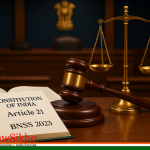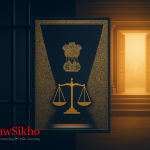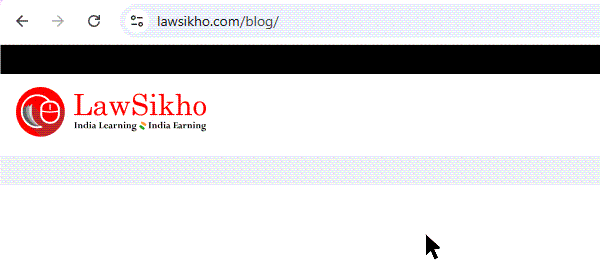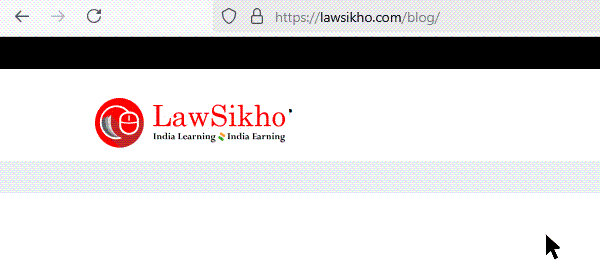The Supreme Court Advocates on Record List is the official directory of qualified lawyers authorized to file and represent cases before India’s apex court. Learn how to access, search, and interpret this verified list maintained by the Supreme Court Registry, featuring AOR codes, chamber details, and current statistics for 2025.
Table of Contents
“How do I find a lawyer who can actually file my case in the Supreme Court?”
This question stumps thousands of litigants every year.
You might have the best High Court lawyer, a solid legal case, and the determination to fight, but without knowing about the Supreme Court Advocates on Record List, you’re searching in the dark.
Here’s what most people don’t realize: your regular lawyer, no matter how experienced, probably cannot file your Supreme Court case.
That right belongs exclusively to Advocates on Record (AORs), and there’s exactly one official place to find them, the Supreme Court’s official AOR list maintained by the Supreme Court Registry itself.
Out of over 20 lakh advocates practicing across India, only 3,789 hold the exclusive right to file cases before the Supreme Court.
This isn’t a privilege granted by connections or seniority; it’s earned through rigorous qualification.
The Supreme Court Advocates on Record List is the authoritative directory containing every one of these qualified practitioners, complete with their contact details, registration information, chamber addresses, and current practice status.
Whether you’re a litigant facing Supreme Court litigation, an advocate expanding your practice to India’s apex court, a law student mapping your career trajectory, or a legal researcher studying the profession, understanding how to access and use this list is essential.
Unlike private legal directories that can’t verify current registration status or update when advocates are suspended or removed, the official AOR list carries legal authority because it’s maintained directly by the institution that grants, tracks, and revokes AOR status.
This comprehensive guide shows you exactly how to access the Supreme Court AOR list through official channels, what information each entry contains, how to interpret technical details like AOR codes and registration dates, and most importantly, how to use this critical resource strategically based on your specific needs.
From finding qualified representation to verifying credentials, identifying mentors, or conducting research, you’ll learn to extract maximum value from India’s most authoritative directory of Supreme Court practitioners.
How to Access the Supreme Court Advocates on Record List?
You can access the official list of Advocates on Record (AORs) from the Supreme Court of India’s website.
The Supreme Court of India maintains an official, comprehensive directory of all Advocates on Record (AORs) qualified to practice before the apex court.
Accessing this authoritative list is essential whether you’re a litigant seeking representation, an advocate verifying credentials, or a legal professional researching Supreme Court practitioners.
Official Supreme Court Website
The Supreme Court provides multiple access methods to ensure transparency and public availability of this critical legal resource.
You can access the AOR list through the Supreme Court’s official website at sci.gov.in, which offers both a searchable online database and a downloadable PDF document.
The online search tool allows you to find specific advocates by name or unique AOR code, providing instant results with contact details and registration information.
For comprehensive research or reference purposes, the downloadable PDF contains the complete registry of all registered AORs, updated periodically with specific date stamps indicating the list’s currency.
Before using the list, it’s important to recognize what makes it uniquely authoritative.
Unlike private legal directories or bar association listings, the Supreme Court AOR list is maintained directly by the Supreme Court Registry based on examination results, registration approvals, and status updates. This official maintenance ensures accuracy and legal validity, making it the definitive reference for AOR verification.
Searching by Advocate Name
To search by advocate name, enter the full name or partial name in the “AOR Name” field on the search form. The system accepts various name formats, though using the complete name (first name, middle initial, surname) yields the most accurate results.
You can also use the “Starts With” dropdown to filter results alphabetically, which is particularly helpful when you’re uncertain about exact spelling or want to browse advocates with similar names.
Searching by AOR Code
If you already know an advocate’s unique AOR code, enter it directly in the “AOR Code” field for precise results.
This search method is particularly useful for verification purposes when someone has provided their AOR code and you want to confirm it matches their claimed identity. The AOR code search returns only the specific advocate associated with that unique identifier, eliminating any ambiguity that might arise from common names.
What Information Does the Supreme Court Advocates on Record List Contain?

The Supreme Court AOR list includes key details about each registered Advocate on Record, such as their AOR code, registration date, office address (within 16 km of the Court), contact details, and status remarks.
It serves as an official directory for verifying credentials and professional information of Supreme Court practitioners.
Understanding what information appears in the list helps you extract maximum value, whether you’re seeking representation, verifying credentials, or conducting legal profession research.
The list structure follows a standardized format maintained by the Supreme Court Registry, ensuring consistency across all entries.
What distinguishes this list from other legal directories is its official authentication by the Supreme Court itself.
Every data point, registration dates, AOR codes, chamber locations, and status remarks are verified and maintained by the Supreme Court Registry based on official documentation, examination results, and formal notifications.
This authoritative validation makes the list the definitive source for AOR related information, with legal standing that private directories cannot match.
Contact and Identification Details in Supreme Court Advocates on Record List
Each AOR entry in the Supreme Court list includes specific contact and identification information designed to facilitate communication between litigants, advocates, and court officials.
These details serve both administrative purposes within the court system and practical purposes for those seeking to engage an AOR for Supreme Court representation.
The three core identification elements: AOR code, chamber address, and contact details, form the foundation of each directory entry.
AOR Code and Registration Number
The AOR code is a unique alphanumeric identifier permanently assigned to each advocate upon registration with the Supreme Court.
This code typically follows a specific format and appears on all official Supreme Court documents, case filings, and correspondence involving that advocate.
The AOR code serves as the primary credential for verifying an advocate’s registration status and remains constant throughout their career, making it an essential reference point for all Supreme Court practice activities.
Chamber Address and Location Details
The list includes each AOR’s chamber location within the Supreme Court premises, usually identifying the specific block and chamber number.
Many entries also include the advocate’s registered office address, which must be located within 16 kilometers of the Supreme Court as per registration requirements.
These addresses serve as official correspondence points for all court communications related to the advocate’s cases and provide litigants with physical locations for in person consultations.
Phone Numbers and Email Addresses
Recent versions of the AOR list include direct contact phone numbers and email addresses for most registered advocates, significantly improving accessibility for clients and fellow legal professionals.
These contact details are verified during registration and updated when advocates notify the Supreme Court Registry of changes.
Having this direct contact information eliminates the need for intermediary referrals and enables immediate outreach for case consultations, collaboration discussions, or professional networking.
Professional Status and Designations in Supreme Court Advocates on Record List
Beyond basic contact information, the AOR list contains professional status indicators that provide context about each advocate’s career stage, experience level, and special recognitions.
These status details help users assess an advocate’s qualifications and understand their position within the legal profession’s hierarchy.
The three key professional markers: registration date, Senior Advocate designation, and judicial elevation, offer insights into career progression and professional standing.
Registration Date and Experience Level
The registration date shown for each AOR indicates when the advocate was formally registered after passing the examination and completing all requirements under the Supreme Court Rules.
An advocate with a registration date of, say, 10/05/2005, has potentially practiced before the Supreme Court for two decades, suggesting substantial experience with apex court procedures and case law.
While registration date doesn’t guarantee active practice volume, it provides a reliable baseline indicator of how long an advocate has held Supreme Court filing rights.
Senior Advocate Designations
When an entry includes the notation “Designated as Senior Advocate w.e.f. [date],” it indicates the advocate has received the prestigious Senior Advocate designation from either the Supreme Court or a High Court.
Senior Advocates are recognized for exceptional legal expertise and professional excellence, typically commanding premium fees and handling complex, high profile matters. Many AORs who achieve Senior designation maintain their AOR status, allowing them to both argue cases with distinction and retain filing rights.
Judicial Elevations and Career Changes
The list includes remarks noting when AORs transition to judicial positions, marked as “Elevated as Judge, [Court Name], on [date].”
Notable examples include several Supreme Court judges who previously practiced as Advocates on Record, demonstrating the AOR system as a pathway to judicial appointment.
These entries remain in the list for historical record keeping, showing the career progression of prominent legal professionals and illustrating the connection between AOR practice and judicial elevation.
Special Notations and Status Changes in Supreme Court Advocates on Record List
The remarks column in the AOR list contains dynamic information about status changes, special circumstances, and administrative notations that affect an advocate’s current practicing status.
These remarks transform the list from a static directory into a living document that reflects the ongoing changes within the Supreme Court bar. Understanding how to interpret these notations is crucial for determining whether an advocate is currently authorized to practice.
Active, Suspended, or Expired Status
Active AORs typically have entries with no negative status remarks, showing only their basic registration information and possibly positive notations like Senior Advocate designation.
When you see an entry without any status warnings, you can generally assume the advocate is currently authorized to practice and available for representation, subject to verification through the Supreme Court’s online search tool, which typically filters inactive entries.
Suspended status appears when an advocate faces temporary practice restrictions pending disciplinary proceedings or administrative matters. The notation “Suspended from practice” or similar language indicates the advocate cannot currently represent clients before the Supreme Court.
Similarly, “Expired on [date]” sadly indicates the advocate has passed away, marking the entry for historical purposes while clearly showing they’re no longer available for practice.
Voluntary Removals and Reinstatements
The notation “Removed on own request” indicates an advocate voluntarily withdrew their AOR registration, possibly due to retirement, career changes, or personal reasons.
This differs from disciplinary removal and reflects the advocate’s choice to relinquish their Supreme Court practice rights. Some advocates request removal when they take up positions incompatible with private practice or when they decide to focus exclusively on the High Court or other judicial forums.
Reinstatement cases appear with remarks like “Re-registered vide order dated [date],” showing advocates who previously left the AOR registry but later returned to Supreme Court practice.
These reinstatement notations demonstrate the system’s flexibility in accommodating advocates whose career paths include temporary departures from apex court practice, whether due to judicial service, government positions, or other professional commitments.
CC Code and Internal Identifiers
The CC (Court Code) is an internal administrative identifier used by the Supreme Court’s case management and registry systems for tracking and cross-referencing purposes.
This code appears in AOR list entries as part of the comprehensive data structure maintained by the Supreme Court Registry. While the CC code primarily serves internal administrative functions, its presence reflects the sophisticated record-keeping systems that support Supreme Court operations.
The CC code enables court staff to link AOR profiles with case filing records, correspondence databases, chamber allocation systems, and other internal Supreme Court infrastructure.
How to Use the Supreme Court Advocates on Record List?
The Supreme Court AOR list serves multiple practical functions depending on your role in the legal ecosystem.
Litigants use it to find qualified representation for Supreme Court cases, legal professionals consult it for credential verification and collaboration opportunities, while law students and researchers analyze it to understand career pathways and profession demographics.
Knowing how to extract relevant information based on your specific needs transforms the list from a simple directory into a strategic resource.
Your approach to using the list should align with your objective and the type of information you need.
If you’re a litigant facing Supreme Court litigation, you’ll focus on finding AORs with accessible contact information and evaluating their experience through registration dates.
If you’re an advocate seeking to verify credentials or find collaboration partners, you’ll use the list’s search functionality to confirm registration status and identify suitable practitioners.
If you’re a researcher or student, you’ll analyze aggregate patterns in the complete PDF list to understand the profession structure and career timelines.
The key to effective list usage is understanding both what information it contains and what it doesn’t.
The list provides identification, contact details, registration dates, and status notations, but it doesn’t categorize advocates by practice area specialization, case success rates, or fee structures.
For Litigants Seeking Supreme Court Representation
When you need to file a case in the Supreme Court, your first practical step is identifying and engaging an Advocate on Record. The AOR list provides your starting point for this search, though selecting the right advocate for your specific case requires considering factors beyond what appears in the list itself.
How to Choose an AOR from the List
Start by using the Supreme Court’s website to identify multiple AORs, paying attention to registration dates to assess experience levels and noting chamber locations to understand accessibility.
Look for advocates registered at least 5-7 years ago for substantial Supreme Court experience, though newer AORs may offer competitive fees and dedicated attention.
You’ll need to combine list information with additional research, such as visiting advocate websites or seeking professional referrals, to make fully informed decisions about representation or collaboration.
What to Look for in AOR Contact Details
When reviewing contact information in the AOR list, prioritize entries with both phone numbers and email addresses for easier initial outreach.
Note whether the chamber address is within the Supreme Court premises (indicating dedicated Supreme Court practice) or lists an external registered office.
If you’re not Delhi based, consider whether the AOR maintains offices or regular practice in your region, though remember that all AORs must have an office within 16 kilometers of the Supreme Court regardless of their primary practice location.
Questions to Ask Before Hiring an AOR

Once you’ve identified potential AORs from the list, your next step involves direct consultation to assess suitability for your specific case.
Ask about their experience with cases similar to yours, while the list doesn’t categorize by practice area, advocates often specialize in constitutional matters, civil appeals, criminal matters, taxation, or other areas.
Inquire about their fee structure, including petition drafting charges, appearance fees for hearings, and whether they charge separately for conferences and consultations.
Discuss their availability and expected timeline since Supreme Court cases often involve multiple stages from admission hearings to final disposal, and you need an advocate who can commit to your matter throughout this journey.
Ask whether they typically argue cases themselves or engage Senior Advocates for court appearances, as this affects both strategy and costs.
Finally, request references or information about recent cases they’ve handled, helping you assess their expertise and track record in Supreme Court litigation.
For Advocates and Legal Professionals
Advocates practicing in High Courts, District Courts, or specialized tribunals frequently need to engage with the AOR system when their clients’ matters reach the Supreme Court.
The AOR list facilitates these professional connections, enables credential verification for collaboration or hiring decisions, and helps you identify mentors if you’re planning to pursue the AOR qualification yourself.
Understanding how to leverage the list for professional purposes strengthens your practice’s Supreme Court capabilities.
Verifying AOR Credentials and Registration Status
When someone claims to be an Advocate on Record, whether a potential collaborator, a candidate you’re considering hiring, or an advocate recommended by a client, verify their credentials by searching the Supreme Court’s official AOR list.
Check for any negative status remarks like “removed,” “suspended,” or “expired” that would indicate they cannot currently practice as an AOR.
Finding Senior AORs for Mentorship and Training
If you’re planning to pursue an AOR qualification, you must complete one year of training under a registered AOR before becoming eligible for the examination.
Use the AOR list to identify potential training mentors by searching for advocates with registration dates at least 10-15 years ago, suggesting sufficient experience to provide quality mentorship.
Look for AORs in practice areas aligned with your interests, though remember the list doesn’t categorize by specialization, so you’ll need additional research to identify appropriate mentors.
Consider geographic factors when identifying training AORs. If you plan to be Delhi-based during your training year, focus on advocates with Supreme Court premises chambers.
If you’re hoping to train while maintaining your existing practice elsewhere, look for AORs who practice in your region or who might accommodate flexible training arrangements.
Reach out to multiple potential mentors to discuss training opportunities, as availability and requirements vary significantly among practitioners.
For Law Students and Researchers
Law students and aspiring advocates can use the AOR list as a research tool to understand the Supreme Court practice landscape.
Understanding the Exclusivity of Being on This List
With approximately 3,789 registered Advocates-on-Record compared to over 20 lakh (2 million) advocates enrolled with State Bar Councils across India, being listed as an AOR places you in the top 0.002% of the legal profession.
This mathematical exclusivity stems from rigorous qualification requirements: four years of practice experience as a baseline, one year of specialized training under an existing AOR, clearing the challenging AOR examination (with typical pass rates of 20-30%), and meeting post exam infrastructure requirements like establishing an office within 16 kilometers of the Supreme Court.
The exclusivity isn’t artificial scarcity; it reflects the Supreme Court’s commitment to ensuring only advocates with demonstrated competence in apex court procedures, case law, and professional standards can file cases before India’s highest judicial forum.
This selective system protects litigants while creating inherent professional value for those who achieve AOR status, as all Supreme Court litigation must flow through this limited pool of qualified practitioners.
How AOR Status Impacts Legal Career Trajectory?
Being listed as an Advocate on Record fundamentally transforms your career trajectory by providing exclusive access to India’s highest court for case filing purposes.
This status enables you to build a Supreme Court focused practice, command premium fees that substantially exceed typical High Court rates, and serve clients through all appellate stages without needing to refer Supreme Court matters to other advocates.
The career implications extend beyond immediate practice benefits to include enhanced professional prestige, networking with India’s top legal minds, and potential pathways to Senior Advocate designation or judicial appointment.
The AOR system serves as a proven pathway to the judiciary, as Supreme Court practice provides direct experience with constitutional law, appellate procedure, and the highest standards of legal reasoning.
Even if judicial appointment isn’t your goal, AOR status distinguishes you within the legal profession, attracts high quality cases, and creates opportunities for specialization in complex areas like constitutional law, public interest litigation, or specialized regulatory matters that frequently reach the apex court.
Who are on the Supreme Court Advocates on Record List?
The Supreme Court AOR list encompasses a diverse cross section of India’s legal profession, advocates who have demonstrated specialized competence through the rigorous AOR examination and qualification process.
These practitioners range from recently registered young advocates beginning their Supreme Court careers to veteran practitioners with 40+ years of apex court experience.
What unites this selective group is their exclusive legal authority under Order IV of the Supreme Court Rules, 2013, to file cases before India’s highest judicial forum.
The geographic distribution of AORs reflects both the Supreme Court’s Delhi location and the system’s national reach.
While Delhi based practitioners form a significant proportion due to proximity to the Court and the practical advantages of maintaining chambers within the Supreme Court premises, the list includes AORs from major cities across India, including Mumbai, Kolkata, Chennai, Bangalore, Hyderabad, and other metropolitan centers.
Some AORs maintain hybrid practices, with primary offices in their home cities while meeting the mandatory requirement of a registered office within 16 kilometers of the Supreme Court in New Delhi.
You’ll find advocates who handle diverse Supreme Court matters across multiple legal areas, as well as those who’ve developed specialized expertise in constitutional law, taxation, criminal appeals, arbitration, intellectual property, or other focused practice areas.
The list also includes many advocates who’ve achieved Senior Advocate designation or transitioned to judicial positions, their entries marked with appropriate notations reflecting these career progressions.
Current AOR Statistics (2025)

Understanding the current scale of the AOR system provides context for its exclusivity and the professional opportunities it represents.
The total number of registered Advocates on Record has grown steadily since the system was formalized through the Supreme Court Rules, with particularly notable growth in recent years reflecting both increasing Supreme Court litigation volume and the examination’s expanding reach.
Current statistics reveal both the selective nature of AOR qualification and the system’s gradual expansion.
Total Registered AORs in India
As of the most recent Supreme Court Registry update in 2025, there are approximately 3,789 registered Advocates on Record in India.
This number represents all advocates who have successfully cleared the AOR examination, completed registration requirements, including office establishment and clerk registration, and maintain active status without removal, suspension, or expiration.
Recent Exam Pass Rates and New Registrations
In December 2022, the Supreme Court conducted the AOR examination, where 815 candidates appeared, and 260 advocates successfully qualified, representing approximately a 32% pass rate.
The June 2024 examination saw 356 advocates qualifying for the AOR designation, which represents a significant 37% increase in successful candidates compared to 2022.
These newly qualified advocates, after completing post exam registration requirements, including office proof and clerk registration, are added to the official list within a few months of their exam success.
Conclusion
The Supreme Court Advocates on Record list serves as more than a simple directory; it’s the authoritative registry of India’s most specialized legal practitioners, those who hold the exclusive right to file cases before the nation’s highest judicial forum.
Whether you’re a litigant seeking representation, an advocate verifying credentials, a law student planning your career path, or a researcher analyzing India’s legal profession, understanding how to access and interpret this list empowers you with critical information about Supreme Court practice.
The list’s official maintenance by the Supreme Court Registry ensures accuracy and legal validity that private directories cannot match.
With 3,789 Advocates on Record serving a nation of 140 crore people, the exclusivity and professional significance of appearing on this list reflect the rigorous qualification standards that protect litigants while recognizing exceptional legal competence.
By accessing the list through the Supreme Court’s official website, either via the searchable online database or comprehensive downloadable PDF, you gain transparent insight into who can legally represent you before India’s apex court, how to contact them, and how to verify their credentials for informed decision-making.
Frequently Asked Questions
Where can I find the official Supreme Court Advocates on Record list?
You can download the official Supreme Court AOR list from the official Supreme Court of India website at sci.gov.in. Navigate to the “Advocates” section, select “Advocate on Record,” and you’ll find a link to download the complete PDF list titled “List of AORs as on [date],” with the date indicating the most recent update (as of this writing, the October 2025 version is available).
How do I search for a specific advocate in the Supreme Court Advocates on Record List?
To search for a specific advocate, visit the Supreme Court’s official website, navigate to the Advocate on Record section, and enter either the advocate’s name in the “AOR Name” field or their unique AOR code in the “AOR Code” field.
What is the difference between the Supreme Court list and the SCAORA directory?
The Supreme Court’s official AOR list is maintained by the Supreme Court Registry itself and represents the definitive, legally authoritative record of all registered Advocates on Record. SCAORA (Supreme Court Advocates-on-Record Association) is the professional association of AORs that maintains its own member directory for association purposes.
How many AOR are currently registered in India?
As of the most recent Supreme Court Registry update in 2025, there are approximately 3,789 registered Advocates on Record in India.
Does the Supreme Court Advocates on Record List include contact numbers and email addresses?
Yes, the Supreme Court AOR list includes contact phone numbers and email addresses for most registered advocates.
How often is the Supreme Court Advocates on Record List updated?
The Supreme Court updates the official AOR list periodically throughout the year, typically multiple times, with each version clearly dated (such as “List of AOR’s as on 09.10.2025”). Major updates occur after each annual AOR examination when newly qualified advocates complete registration requirements and are added to the list. The list is also updated when advocates’ status changes due to Senior Advocate designation, judicial elevation, death, or removal.
Can I download the complete Supreme Court Advocates on Record List as a PDF?
Yes, you can download the complete Supreme Court AOR list as a PDF document directly from the Advocate on Record section of the Supreme Court website at sci.gov.in.
How can litigants use the list to hire an advocate for Supreme Court cases?
Litigants can use the AOR list to identify potential advocates by searching by name or browsing the complete PDF, noting registration dates to assess experience levels, and obtaining contact details for initial consultations.
Combine list information with additional research by checking case history, professional websites, and seeking referrals to select an advocate appropriate for your specific Supreme Court matter.
Are senior advocates separately marked in the AOR list?
Yes, advocates who have been designated as Senior Advocates are specifically marked in the AOR list with the notation “Designated as Senior Advocate w.e.f. [date]” in the remarks column. This notation indicates the advocate has received the prestigious Senior Advocate designation from either the Supreme Court or a High Court, recognizing exceptional legal expertise and professional standing.
What does it mean when an AOR is marked as “Expired” or “Removed”?
The notation “Expired on [date]” indicates the advocate has passed away, marking the entry for historical record keeping while showing they’re no longer available for practice. “Removed” notations indicate the advocate either voluntarily withdrew their AOR registration (“Removed on own request”) or was removed due to disciplinary action or other reasons. These status markers clearly indicate that the advocate cannot currently represent clients before the Supreme Court.
How can advocates verify their own AOR registration status?
Advocates can verify their own AOR registration status by searching their name or AOR code in the Supreme Court’s official website at sci.gov.in. Their entry will appear with current registration details, chamber address, and any status remarks.






 Allow notifications
Allow notifications
